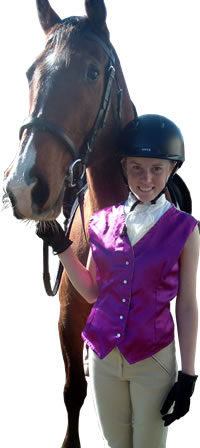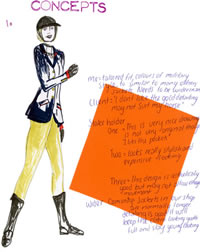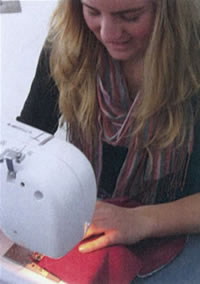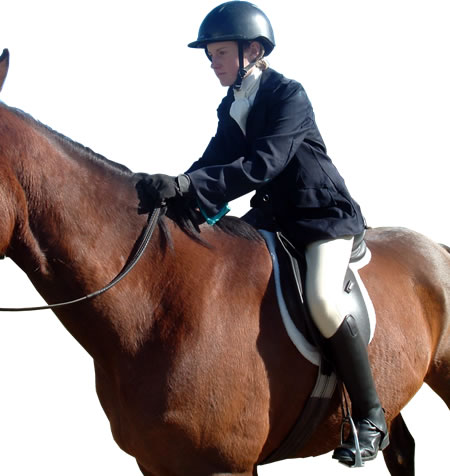Riding high

Ruby Fitzgerald
Motueka High School
Year 13 Soft Materials Technology
W
hole-year project
Teacher: Celeste Ryan
Ruby's younger sister Holly needed a summer equestrian outfit that would perform well, had a unique look, and complied with equestrian trial regulations. Ruby's challenge was to research, design and manufacture this outfit in time for a trial in November, within the strict budget of $150 provided by the financial stakeholder, their mother.
Ruby consulted with her client to establish the elements required of the outfit. Holly explained that ease of movement and performance were just as important as aesthetics, as she would be entering both show-ring and jumping events. The garment should also be durable and have a classic design that wouldn't date too quickly while remaining unique enough to stand out. Other specifications included being cool in summer, being easy to clean, and having a professional well-constructed finish.
Ruby began by researching the separate garments required to meet the regulations, then looked into the many variations possible within those guidelines. She then collected a large selection of images of different riding garments and showed these to Holly and her mother for their opinions. With this feedback, Ruby decided to make a jacket, sleeveless shirt, waistcoat, and stock collar , she then developed a series of concept drawings of style options for each garment. The pros and cons of each design were discussed with her client and stakeholder until a final design was chosen for each.
 For the jacket, a simple yet stylish design was selected primarily for its versatility – it could be worn with or without a waistcoat and was smart enough for show-ring, yet comfortable enough for jumping. Its design was very flattering to her client, and being classic, rather than trendy, ensured it could be worn for several seasons. The shirt was sleeveless with breathable panels to keep Holly cool, and was smart enough to be worn without the jacket if necessary. Though these basic designs remained throughout the course of the project, many small changes occurred on an aesthetic level, such as changing the size, shape and colour of collars, hemlines and pockets.
For the jacket, a simple yet stylish design was selected primarily for its versatility – it could be worn with or without a waistcoat and was smart enough for show-ring, yet comfortable enough for jumping. Its design was very flattering to her client, and being classic, rather than trendy, ensured it could be worn for several seasons. The shirt was sleeveless with breathable panels to keep Holly cool, and was smart enough to be worn without the jacket if necessary. Though these basic designs remained throughout the course of the project, many small changes occurred on an aesthetic level, such as changing the size, shape and colour of collars, hemlines and pockets.
Many of these decisions were determined and trialled through the mock-up stage, where Ruby began creating trial garments for fitting and design development. Ruby created the patterns for the waistcoat and stock herself and based the shirt on a 1970s blouse pattern. While Ruby says the sewing for these garments went relatively smoothly, the jacket pattern, based on one taken from a magazine, was another matter altogether.
"I found this pattern so difficult and hard to understand. The instructions were very brief and used technical language that even 'Google' did not recognise."
Perseverance saw Ruby completing the first mock-ups and fitting them to her client, leading to a few design changes before the final fabric purchases. Ruby created a list of fabrics needed and their estimated amounts, and shopped for her materials during a holiday in Wellington. She managed to source most of her first fabric choices but couldn't find the silver pinstripe material for the back of the waistcoat – her gamble in choosing instead a green and purple plaid fabric found in a remnant bin paid off, as Holly and her mother loved it.
Further developments were then made to the concept drawings, but planning the construction stage turned out to be frustrating: "I found it really difficult, as the figures didn't turn out how I wanted most of the time or I would make a mistake and have to redo it time and time again until it was right."

Ruby is proud of what she has accomplished with her design and attributes the success of her project to the good technological practice that she followed throughout the project. "My planning was so helpful and kept me on task throughout the project and I would refer to it often to see what to do next. I feel my work meets the relevant codes of practice as the outfit is safe, meets all the legal requirements and has an original design that my client and stakeholder are really happy with."
Teacher comment
Ruby is a very self-managing student and worked independently with little help throughout this project. She planned thoroughly, so her project and practice just flowed; when she did come across problems she would problem-solve and try different ways forward until she found a way that worked. Modelling and testing was done throughout to ensure that the designs looked good when put together as an outfit, and the fabrics were thoroughly researched so that the most breathable and lightweight fabrics were chosen to suit the environment and use. Each garment has been constructed to a high quality and Ruby has created a very technical and successful outcome that has been used for several equestrian events already.







